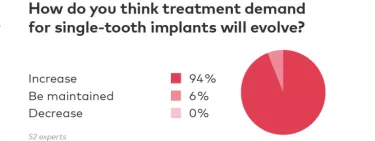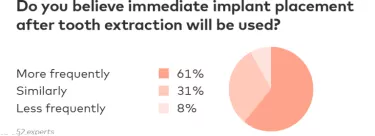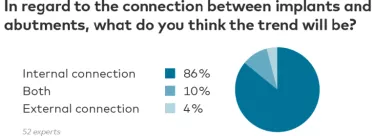
The future of dental implants: What are potential trends in the 2020s?

A professor at the University of Zurich’s Clinic of Reconstructive Dentistry, Prof. Christoph Hämmerle is co-author of Delphi Study – Horizon 2030 , a report published by the European Association of Osseointegration (EAO), aimed at identifying possible future trends in European implantology until 2030. We spoke with him to discover more about the study’s main findings and what they might mean for clinicians offering implant treatments.
Prof. Hämmerle, what was your methodology for Delphi Study – Horizon 2030?
In line with the Delphi method, a wide range of implantology experts from around Europe were invited to take part in a questionnaire and a consensus meeting, and we ranked the responses based on the level of consensus; a high consensus meant 86 to 100% agreed on a response; a moderate consensus was 65 to 85%; and no consensus meant the threshold of 65% was not met. 138 experts were invited to participate; 56 answered the questionnaire in the first round, and 52 participated further in the second round.
We tried to find a balance of experts from the different oral healthcare models in Europe, plus a mixture of those active in academia, private practice, or a combination of both. Of course, when you talk about implantology, many different aspects define how a particular treatment should proceed. For this survey, many of the times in which no consensus was reached were due to differences in opinion and how the respondents interpreted certain questions.
Patient demand for dental implants
What are the predictions of patient demand for dental implants?
There was general consensus that patient demand will increase, and that there will be both more single-tooth implant cases and short-span, implant-supported fixed restorations.
At the same time, the majority, (though without consensus), believed that demand for fixed implants from fully edentulous patients would decrease. However, here we can see some of the issues that arose with the questionnaire – if you agree that the demand for implants will go up, is it purely because more people will receive implants, or does it indicate that you expect the percentage of patients with implants to increase? Generally speaking, however, we can say that the experts surveyed believe that more patients will receive implants, but that implant-bone reconstructions will be smaller.
These expectations regarding future patient demands are also different if you consider how ‘dentally developed’ the country is. For those countries in Europe that are considered ‘dentally developed’, there are expected to be increases in implant treatment demand due to such factors as an ageing wealthy population.
Trends in implant treatment times
Nobel Biocare sees shorter time-to-teeth as a priority. What were the findings of the study in relation to treatment times, such as immediate placement and immediate loading?
Though we could not find a consensus on immediate implant placement after tooth extraction, the expert panel eventually agreed that this treatment modality would either be used more frequently or at a similar level in the future.
The lack of consensus was not because shorter time-to-teeth is not valuable for patients, but the belief that more general practitioners will be placing implants who are perhaps less experienced and more conservative. These practitioners are less likely to conduct immediate loading or placement.
Other questions were asked about the frequency of implant placements with simultaneous bone regeneration and with soft tissue reconstruction. Respondents reached a consensus that each surgical protocol will be more frequent. In addition, there was a moderate consensus that agreed immediate loading protocols will be used more frequently. Each of these factors, of course, would reduce the average treatment time for implant patients.
It’s worth also stating that these opinions are on what they expect to happen, and do not reflect the values that the experts personally hold when it comes to implantology.
Future of dental implant design
What were your findings regarding implant design?
We found a high consensus regarding implant–abutment connections. This connection is expected to be internal, though the study did not look at the specific shape of this internal connection.
There was also moderate consensus that cylindrical and tapered implants will both continue to be used, but the tapered design will be more favored.
In addition, bone-level implants were found to be the preferred design for the implant neck placement due, in part, to an increased demand for esthetics.
Increase in peri-implantitis
Did you find any changes in the expected prevalence of conditions such as peri-implantitis?
Yes, there was a consensus that the prevalence of peri-implantitis will likely increase as there will be more implants being placed in the future, and such conditions as these often take time to develop. However, it is also expected that improvements in implant materials, as well as better diagnostic parameters, may help to reduce peri-implantitis.
With more general dentists entering implantology, there’s an understanding that continuous prevention needs to be highlighted. This approach is perhaps more widely practiced in periodontology than implantology currently, and a lot of it has to do with training. There are a number of studies that show a relationship between better training and a reduced amount of complications.
Digital workflows
What about the expansion of digital procedures and workflows in the dental practice?
It’s expected that CBCT imaging will play a greater role in pre-surgical diagnosis and treatment planning. There’s also an expectation that biomarkers and new probing methods will allow for the monitoring of peri-implant health and disease. On the whole, we found that while the experts surveyed expect innovation in terms of digital procedures and technologies, these will be integrated alongside more traditional approaches such as probing.
It is also expected that digital technologies will play a greater role in what we termed ‘restorative diagnoses’, with a high consensus emerging that this approach will replace standard diagnostic procedures.
The majority of respondents also predicted that guide-oriented protocols will be used for future implant placement, with fully-guided methods employed in more complex cases.




